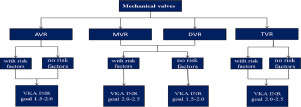当前位置:
X-MOL 学术
›
Eur. J. Pharm. Sci.
›
论文详情
Our official English website, www.x-mol.net, welcomes your
feedback! (Note: you will need to create a separate account there.)
Optimal oral anticoagulant therapy in Chinese patients with mechanical heart valves.
European Journal of Pharmaceutical Sciences ( IF 4.3 ) Pub Date : 2019-12-19 , DOI: 10.1016/j.ejps.2019.105202 Heng Zhang 1 , Yijun Dong 2 , Xuelian Ao 3 , Da Zhu 1 , Li Dong 1
European Journal of Pharmaceutical Sciences ( IF 4.3 ) Pub Date : 2019-12-19 , DOI: 10.1016/j.ejps.2019.105202 Heng Zhang 1 , Yijun Dong 2 , Xuelian Ao 3 , Da Zhu 1 , Li Dong 1
Affiliation

|
BACKGROUND
The oral administration of anticoagulants is an effective means of preventing thromboembolic complications in patients implanted with mechanical valves. This treatment strategy, however, entails a dose-dependent in the risk of hemorrhage that is a cause for concern in China. As such, in this study, we sought to better determine what the ideal oral anticoagulant therapy intensity is in a Chinese population of patients implanted with mechanical valves.
METHODS
In the present observational cohort study, we observed the outcomes of eligible enrolled patients that had been implanted with St. Jude Medical prosthetic valves and who had been treated at our institution from 2013 onwards. All enrolled patients were followed for between 1 and 6 years through outpatient visits or telephone interviews following discharge. Study endpoints included instances of thromboembolism and major hemorrhage. We calculated the international normalized ratio (INR)-specific incidence of such adverse events as a means of determining optimal anticoagulant therapeutic intensity in patients with these bileaflet mechanical valve prostheses.
RESULTS
In total this study enrolled 3176 patients, of whom 3017 were followed for 12,746.08 total person-years (4.22 mean years per patient), while the remaining 159 patients (5%) were lost during follow-up. A total of 182 patients suffered from adverse events, with a roughly 1.43% annual incidence rate of such adverse events (95% confidence interval [CI], 1.22-1.64). Of these, 54 patients suffered from episodes of major bleeding (0.42% per patient-year, 95% CI, 0.31-0.53), while 131 suffered from thromboembolism (1.03% per patient-year, 95% CI, 0.85-1.21). Based on these analyses, we determined that the ideal low-intensity anticoagulant treatment regimen for patients with bileaflet mechanical heart valve prostheses was an INR between 1.5 and 2.5. In those patients that had undergone aortic valve replacement (AVR), the optimal INR was between 1.5 and 2.0 regardless of any thromboembolism risk factors in these patients. In contrast, in patients that had undergone mitral valve replacement (MVR) who were not at risk for thromboembolism, the optimal INR was between 1.5 and 2.0, whereas in those at risk of thromboembolism the optimal INR was between 2.0 and 2.5. The ideal anticoagulant intensity in patients undergoing both AVR and MVR (DVR) was the same as in patients undergoing MVR alone.
CONCLUSIONS
In order to achieve optimal outcomes by maintaining effective anticoagulant dosing while entailing minimal risk in Chinese patients that have undergone a bileaflet mechanical valve replacement, the target INR range should be between 1.5 and 2.5, with the final intensity of this anticoagulant regimen being determined based on a given patient's risk of thromboembolism.
更新日期:2019-12-20











































 京公网安备 11010802027423号
京公网安备 11010802027423号